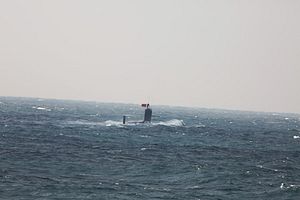The submarine spotted in Japan’s contiguous zone in the East China Sea last week alongside a frigate was a Chinese People’s Liberation Army-Navy (PLAN) Shang-class (Type 093) nuclear attack submarine (SSN), Japanese Defense Minister Itsunori Onodera said on Monday.
Onodera’s statement definitively clarifies the vessel’s type, days after the Japanese government protested to China over an intrusion by a PLAN frigate and the SSN into the contiguous zone around the disputed Senkaku/Diaoyu Islands in the East China Sea. The Japanese government had initially not identified the submarine as a Chinese vessel, but the Defense Ministry later confirmed that a Japanese Maritime Self-Defense Force escort vessel had tracked the submarine since January 10.
“We are seriously concerned over acts that unilaterally raise tensions. We’ll keep our guard up to respond swiftly if a similar incident happens,” Onodera told reporters on Monday. Last week’s incident in the East China Sea was the first time a PLAN submarine had entered Japan’s contiguous zone around the Senkakus. China Coast Guard vessels and civilian fishing trawlers have regularly entered both the territorial sea and the contiguous zone around the islands since Japan’s decision to nationalize the Senkakus in 2012. PLAN incursions are rarer, but in the summer of 2016, for example, a PLAN frigate entered the contiguous zone around the Senkakus for the first time in more than a decade.
Chinese Shang-class submarines use nuclear propulsion and have conducted extended deployments into the Indian Ocean and China’s near seas. China is thought to currently have two submarines in active service, with three more undergoing trials. In addition to torpedoes, the submarines are equipped with vertical launch systems (VLS) that can accommodate YJ-18 anti-ship and land-attack cruise missiles. (An improved version of the Shang-class can accommodate CJ-10 cruise missiles.)
Also on Monday, three China Coast Guard vessels entered Japan’s territorial waters off the Senkaku Islands, the second such intrusion since the start of the year. Just a little more than a week ago, four China Coast Guard vessels had entered Japanese territorial waters off the Senkakus. According to the Japan Coast Guard, the vessels entered Japan’s territorial waters near the islet of Uotsuri—the largest of the Senkaku group—and spent around ninety minutes in Japan’s territorial sea.
Last week’s incident and Monday’s incursion in the East China Sea raises tensions between China and Japan shortly after an improvement in ties in late-2017. Chinese President Xi Jinping met Japanese Prime Minister Shinzo Abe on the sidelines of the Asia-Pacific Economic Cooperation leaders’ meeting in Da Nang, Vietnam, in November, and the two sides reached a breakthrough on their long-sought East China Sea crisis management mechanism in early December 2017.

































